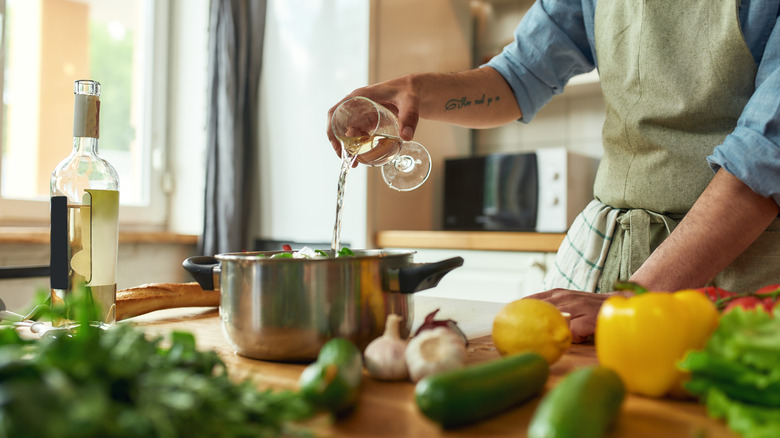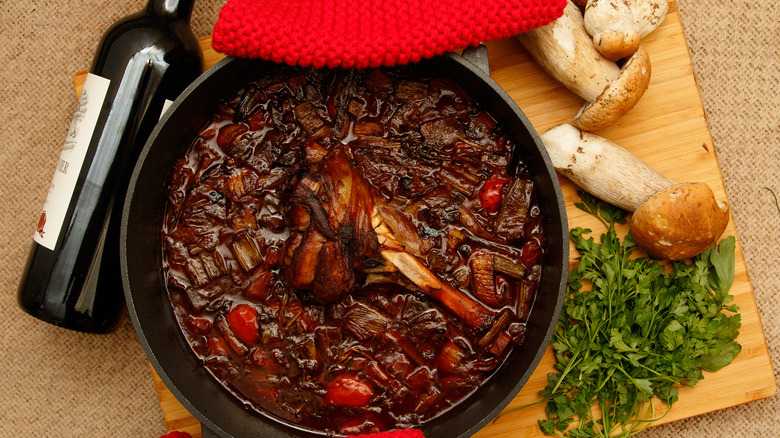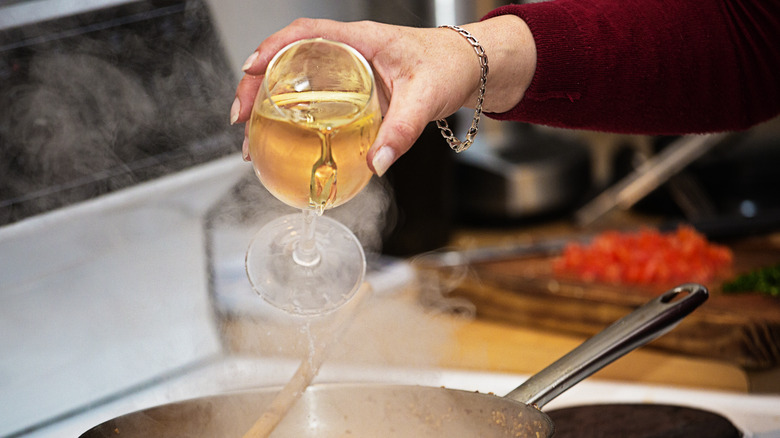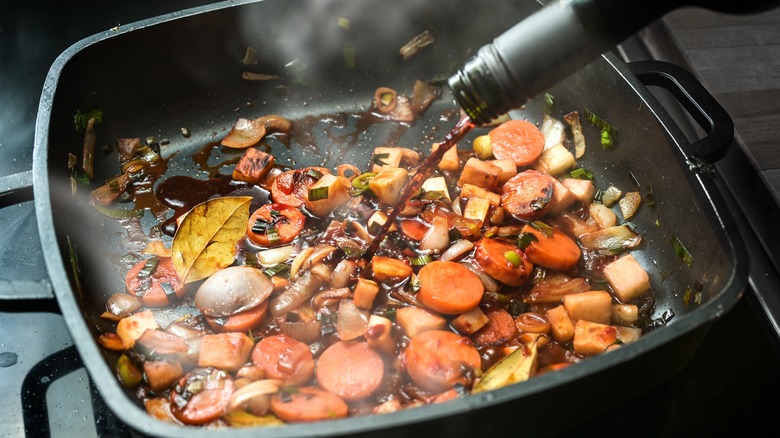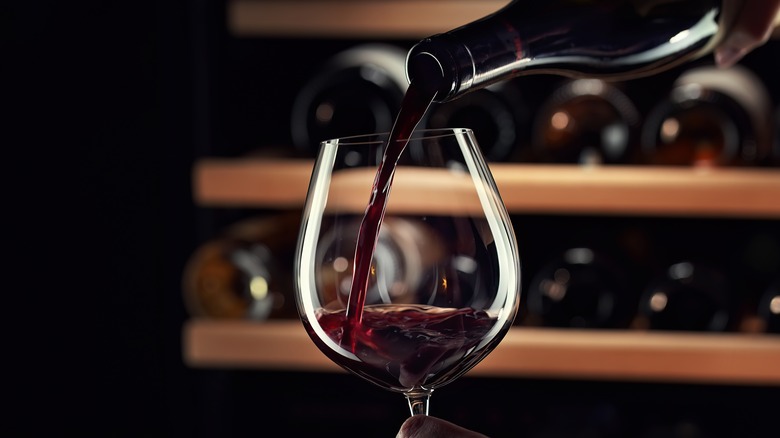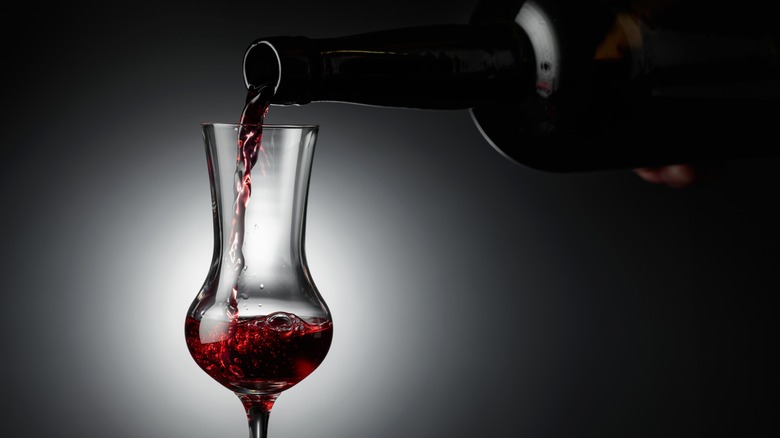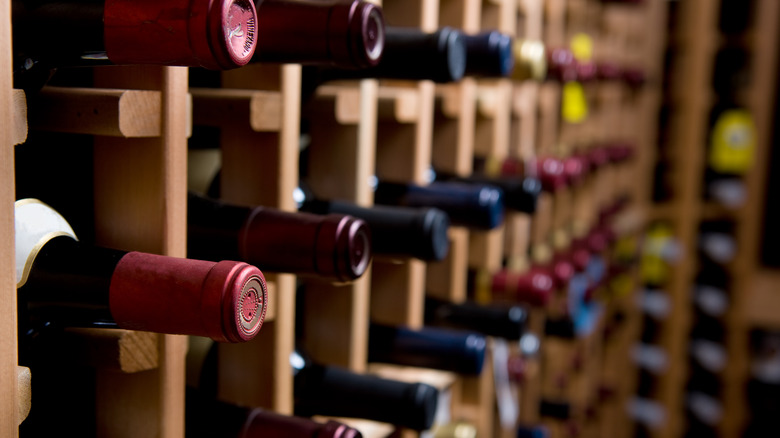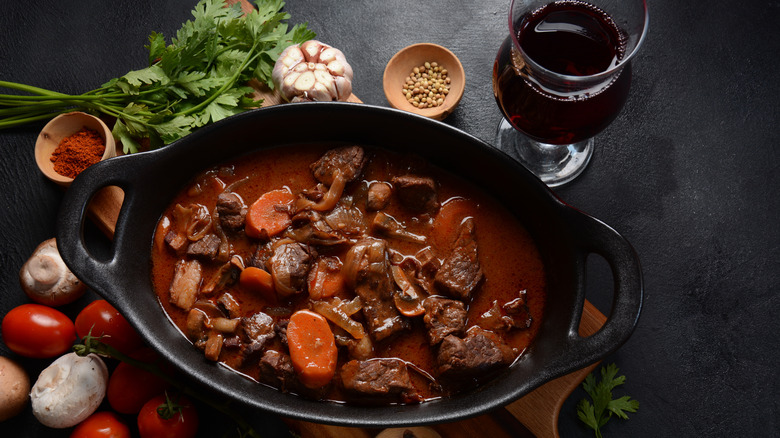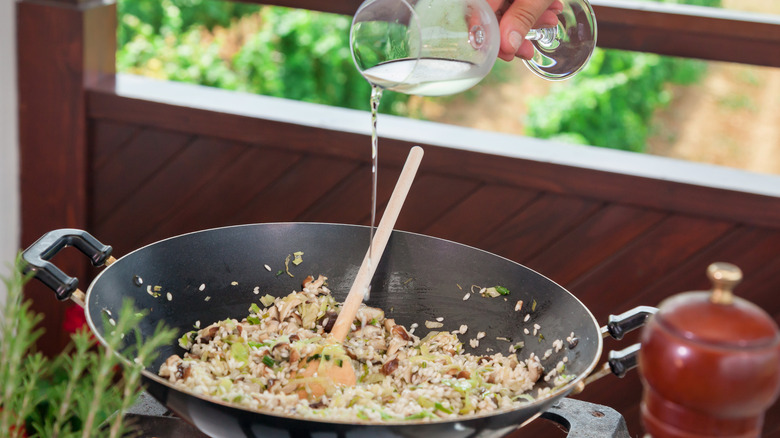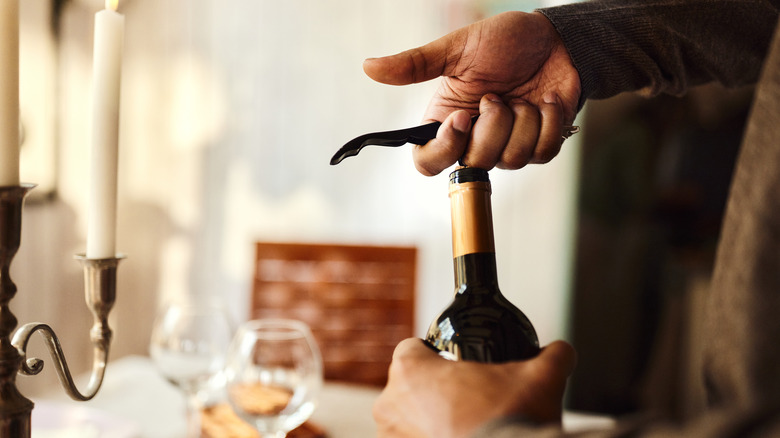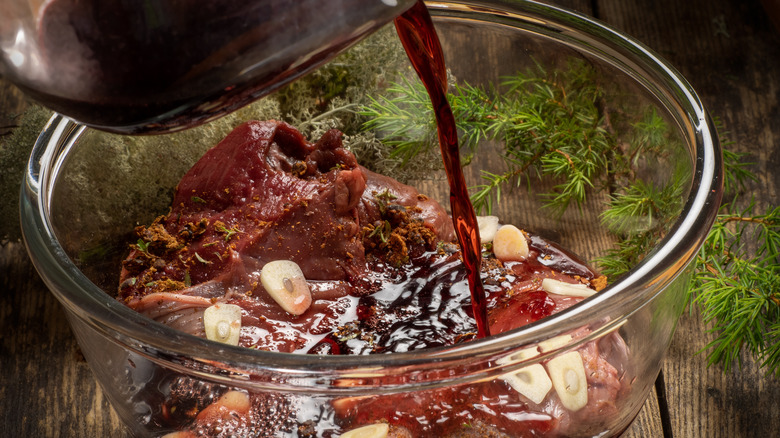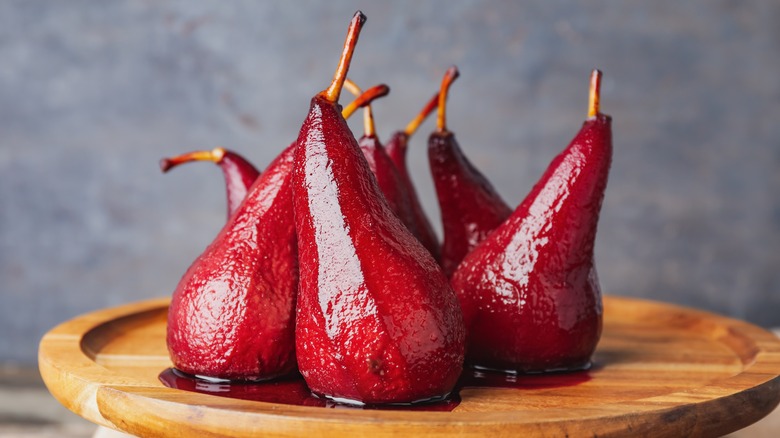Big Mistakes To Avoid Making When Cooking With Wine, According To Chefs
Cooking with wine can elevate the flavors of a wide range of dishes, adding depth and complexity to seemingly anything, from hearty stews to delicate sauces. Wine can transform ordinary recipes into something extraordinary. However, as easy as it might seem to pour a glug from your favorite bottle into a waiting pot, there's an art to cooking with wine that goes beyond simply adding it to the pan.
While wine can enhance your dishes, it can also lead to some less-than-appetizing results if you don't know what you're doing. From overpowering flavors to unpleasant aftertastes, the mistakes made when cooking with wine can turn a delightful meal into a less-than-appetizing experience.
As an experienced home cook, recipe developer, and food writer with previous experience in the food service industry, I'm no stranger to cooking with wine. However, nobody has all the answers, so I scoured the web to find opinions from chefs, recipe writers and sommeliers on the mistakes to avoid when cooking with wine. Here are some of the biggest mistakes to avoid when you use wine in cooking, according to chefs and other food professionals.
Using expensive wine for dishes that cook a long time
It might seem like the fancier the wine, the better your finished dish will be. However, it's a mistake to use an expensive wine in recipes that call for a long cooking time, as chef Alex Guarnaschelli told Food & Wine. That's because expensive wines often have intricate flavor profiles, with layers of aromas and tastes that make them enjoyable to drink. When these wines are subjected to prolonged cooking, especially at high temperatures, the subtleties that make the wine expensive can evaporate. It all leaves you with a dish that does not fully justify the cost of the wine.
It's not that expensive wine will taste bad in a finished dish. It's more that whatever you're eating may not make the best use of its complexities. In other words, pouring an expensive wine into a pot where its characteristics will largely be lost is wasteful both in terms of flavor and cost. It's more economical and sensible to reserve expensive wines for occasions where they can be savored and enjoyed alone in a glass.
Instead, reach for a more affordable wine when it'll be simmering away in a sauce or stew. This doesn't mean you should use the cheapest wine you can find — or, worse, cooking wine — but a decent low-end wine will likely do the trick.
Using cheap wine for finishing a dish
While you shouldn't use expensive wine when it'll be cooking for a long time, some dishes call for the wine to be added close to the end of cooking. When it'll only be simmering for a few minutes, then it pays to use a pricier wine. If you use cheap wine, the less-than-pleasant flavors of a bottle may then come through.
You should consider good wine more like a finishing oil, as Guarnaschelli told Food & Wine. You wouldn't cook with a super-expensive bottle of extra virgin olive oil, but you would drizzle it over a cooked dish for flavor. Likewise, the quality of wine directly affects the flavor of your dish when it's added at the end. Cheap wines often lack the complexity, balance, and depth of flavor found in higher-end varieties. When used to finish a dish, the subpar taste of the wine can negatively impact the final flavor profile, leaving your meal with a one-dimensional or even harsh taste.
Not using wine to deglaze the pan
Deglazing is a technique that involves adding liquid to a hot pan to loosen and dissolve the flavorful browned bits of food that stick to the bottom. These browned bits are packed with rich, caramelized flavors that develop during cooking. By deglazing the pan, you can reincorporate these delicious remnants back into your dish, enhancing its overall taste and complexity. If you aren't using wine to deglaze your pan, you're making a mistake.
As executive chef Mark Hennessey told Insider, deglazing with wine helps to lift and dissolve the concentrated flavors from the pan, incorporating them into whatever you're cooking. When you do this with wine, it infuses your dish with a depth and richness that cannot be achieved by using water or other liquids.
Deglazing with wine is the foundation for creating flavorful pan sauces. After deglazing, additional ingredients like stock, butter, herbs, and other seasonings can be added to the pan to further develop the sauce. The result is a velvety, flavorful mix that perfectly complements the main dish. By incorporating this technique into your home cooking, you can achieve restaurant-quality results and impress your guests with the nuanced flavor of your meal.
Using red wines that are too tannic
Using red wines that are excessively tannic in cooking, even if you enjoy drinking them, can make your dish taste bad. Tannins are natural compounds found in grape skins, seeds, and stems, which impart a dry, puckering sensation in the mouth. While tannins can contribute complexity and structure to wine, winery chef Jeff Mosher told the Chicago Tribune that they can overwhelm the flavors of a dish when used in cooking.
When you cook wine down, its flavors are concentrated. So, wines hefty on the tannins will be even more tannic after cooking. Tannic wines have a strong, astringent character that can dominate the other flavors in your dish. Instead of enhancing the taste, an overly tannic red wine may overpower your other ingredients, leading to a lack of balance in the final preparation and an unpleasantly bitter edge.
Instead, choose a varietal that's lower in tannins. Pinot noir, Gamay, and dolcetto are all good choices, but you can find plenty more red wine varieties that go lighter on the tannins and will go easier on your dish.
Not considering sweetness
Because a wine's flavors concentrate during the cooking process, it's important to consider sweet as well as bitter. If a wine is already sweet, it can become excessively sugary in the finished dish.
When wine is used in cooking, the natural sugars present in the wine become more concentrated as the liquid reduces and the sweetness will become more pronounced. If the recipe does not account for this increased sweetness, it can lead to a cloying, overpowering taste that masks the other flavors or can make savory dishes start to taste like dessert.
To avoid this issue, select wines with appropriate sweetness levels for your recipes. If you're preparing a savory meal, opt for dry wines with less sugar, unless the recipe calls for something else or you want some amount of sweetness in the finished dish. Always pay attention to the type of wine a recipe calls for. If it tells you to use a dry wine, even an off-dry wine might leave too much of a sugary edge in the finished dish.
Not considering acidity
Understanding the role of acidity in wine is essential when it comes to cooking, as — like sweetness — acidity intensifies and concentrates during the cooking process. Acidity is a key component in many wines, providing freshness, brightness, and balance. However, when cooking, acids present in the wine do not evaporate like water or alcohol. Instead, they become more concentrated as the liquid reduces, intensifying the sourness in the dish. This concentration of acidity can overwhelm the other flavors in the recipe.
Using overly acidic wine is a common mistake, especially in recipes that call for a significant amount of wine to be reduced, such as sauces or braises. To avoid this issue, select wines with balanced acidity for cooking. Wines labeled as "smooth," or "well-rounded" often have moderate acidity and can work well in a variety of dishes. Avoid wines described as "high-acid" or "crisp" when cooking, as they are more likely to intensify in acidity during cooking. Common wine varieties with lower acidity include pinot noir, riesling, and sauvignon blanc.
Using wine with a high alcohol content
Using wines with high alcohol content — typically above 14% alcohol by volume (ABV) — in cooking can lead to a harsh, unbalanced taste. According to executive chef Lisa Lanxon, who spoke with The Oregonian, high-alcohol wines tend to have a strong, fiery taste due to the higher concentration of ethanol. When reduced during cooking, this intensity can become overwhelming.
Alcohol also carries volatile compounds that contribute to the aroma of a dish. When using high-alcohol wines, these aromatics can work overtime and lead to an unbalanced olfactory experience. It's important to choose wines that enhance the aroma of the dish rather than dominate it.
DIshes with delicate flavors especially require a wine that complements rather than overwhelms the other ingredients. High-alcohol wines can mask the subtle nuances of herbs, spices, and other aromatic elements, so your meal just ends up tasting like wine and not much else.
Not letting wine cook off before adding more liquid
Allowing wine to cook off before adding more liquid, such as stock or cream, is a crucial step in the cooking process, Guarnaschelli told Food & Wine. This keeps wine from tasting raw in the final dish and ensures that its flavors have a chance to concentrate, enhancing the overall taste and complexity of your recipe.
When wine is added to a hot pan, the liquid evaporates, leaving behind the concentrated flavors of the wine. If you don't allow the wine to cook off and instead immediately introduce other liquids, the wine's raw taste can permeate the dish. The natural sugars, acids, and aromas in the wine won't have the opportunity to meld with the other ingredients and develop the rich, nuanced flavors that result from a more careful reduction.
Properly reduced wine creates a harmonious base for the dish. It integrates seamlessly with other ingredients, ensuring a balanced and well-rounded flavor profile that includes the other ingredients. Allowing the wine to cook down seems like a simple step, but one that will ensure your dish is infused with well-developed, concentrated flavors.
Using cooking wine
When cooking, use a wine suitable for drinking rather than cooking wine. Chef and restaurateur Pascal Sauton told The Oregonian that cooking wine, often found in grocery stores, contains added salt and preservatives that can impart a harsh, artificial taste to your recipes. Wines meant for drinking are generally of higher quality, made with better grapes and a greater attention to the winemaking process. The subtle nuances and complexities of a good wine are what you want in your finished dish. Cooking wine simply doesn't taste great on its own, so why would you want to add it to your food?
What's more, cooking wines often contain additives and preservatives, including salt, to increase shelf life. These can alter the taste of your dish and make it overly salty or unbalanced. Drinking wines, on the other hand, are free from these extra ingredients, ensuring a purer and more authentic flavor in your recipes.
Plus, when you use drinking wine, you have the freedom to choose the type of wine that best complements your recipe. Whether it's a rich red variety for hearty stews, a crisp white for delicate sauces, or a sweet dessert wine for baking, you can select the perfect wine varietal to enhance the specific flavors of your dish.
Avoiding wine that's been open for a week or two
You have an open bottle of wine that's been languishing in your fridge for a week or two. Your first thought might be to pour it down the sink, but it's still good to cook with. While an opened bottle of wine may not be suitable for drinking due to oxidation, heat, and exposure to air, it can still serve its purpose in cooking — as long as you're using it in a recipe where it'll be simmering for a while.
That's because the cooking process significantly alters the wine's flavor profile. As the dish simmers, the wine's flavors should meld with the other ingredients, reducing its sharpness and mellowing out any harsh notes. This transformation often masks the subtle changes that occur after opening the bottle, making the wine still perfectly acceptable for cooking.
Even if it's a bit past its prime, opened wine can still impart depth, aroma, and complexity to your dishes. And let's not forget that cooking with wine that's been opened is cost-effective, too. Instead of discarding leftover wine, put it to good use in your recipes, saving money and minimizing food waste.
Cooking with wine you wouldn't drink — unless you have expensive taste
The adage "never cook with wine you wouldn't drink" carries a lot of truth in the culinary world. The quality of the wine you choose for cooking directly impacts the flavors of your dish. However, the exact interpretation of this rule can vary, especially given all the diverse preferences and budgets out there.
For the majority of people, the wisdom behind this saying is clear: if a wine isn't enjoyable to drink on its own, it's likely to impart undesirable flavors to your dishes, writes chef Darin Sehnert. Wines with off-notes, excessive sweetness, or harsh tannins can negatively impact the taste of your culinary creation. Using a subpar wine can result in a meal that lacks the depth and balance that good wine can bring to a dish.
On the other hand, there are some people whose everyday wine choices are simply too lavish for cooking. If you have a discerning palate and routinely enjoy high-quality, expensive wines, you might find that a more affordable bottle is perfectly suitable for cooking. Expensive wines often have complex flavor profiles that are not always necessary in a cooked dish. In such cases, a decent, moderately priced wine can deliver satisfactory results without breaking the bank.
Not using wine in marinades
If you aren't using wine in marinades, you're missing out. Wine adds complexity to marinades. Its natural acidity and other compounds can penetrate into the food, infusing it with a rich, fruity, and slightly acidic taste (depending on the particular wine, of course).
Wine can blend well with the flavors of other aromatic ingredients in the marinade, such as herbs, spices, garlic, and onions, creating a fragrant and enticing base for your marinated dishes. What's cool about wine is its versatility here. Whether you're marinating poultry, red meat, seafood, or vegetables, you can select a wine that will play well with the specific flavors of the food you're preparing.
Using a bold red wine is a good idea when marinating anything with a lot of flavor that can hold its own, whether that's meat, vegetables, or even halloumi cheese. On the other hand, when marinating ingredients with more subtle flavors, use a lighter-bodied wine. White wines are good here, but so are light reds. As with many of these tips, choose something that you'd be happy to drink.
Ignoring wine when cooking desserts
Using wine exclusively in savory cooking and neglecting its potential in desserts is a missed opportunity, Hennessey told Insider. Whether you're using a red, white, or dessert variety, wine offers a wide array of complex flavors that lend a sophisticated touch to dessert and helps to create a multi-layered taste experience that can be both surprising and delightful.
A more acidic wine can balance the sweetness in desserts, preventing them from becoming overly sugary. The natural sugars in some varieties of wine can also complement the sweetness in desserts like poached fruits, reducing the need for added sugar.
You can also use wine to create syrups, glazes, and sauces that add flavor and a luxurious, glossy texture to desserts. These wine reductions can elevate simple desserts like ice cream, panna cotta, or even a simple mix of fresh berries and whipped cream. Desserts like tiramisu, poached pears in red wine, or chocolate fondue also benefit from the nuanced flavors of wine.
